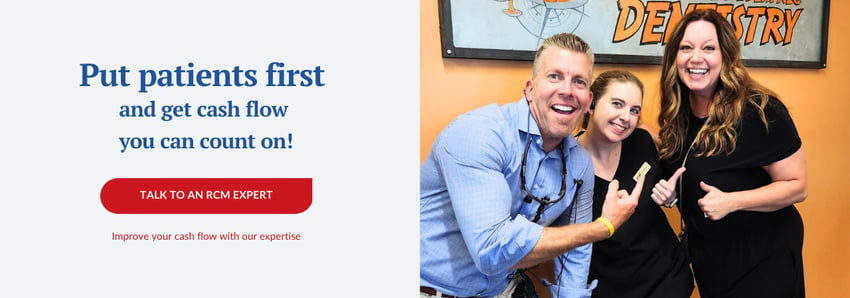When do you need predetermination vs. preauthorization? A quick guide


When you come across two long words that start and end the same way, you might think, “They’re probably similar.” In the dental world, however, the terms predetermination and preauthorization should not be used interchangeably. Knowing when to use each term will save you time and money.
Understanding basic insurance billing terminology is essential for all dental professionals. This knowledge impacts the accuracy of your claims submissions, which in turn affects reimbursements, cash flow, and your bottom line.
Recognizing the difference between a predetermination and a preauthorization can save you time and, in some cases, money.
DCS is an end-to-end revenue cycle management solution for dental and oral surgery professionals aiming to streamline their processes and improve cash flow. Many challenges these oral healthcare businesses face are insurance-related.
In situations like these, our client-partners turn to the DCS Knowledge Network: Our pool of over 100 insurance billing experts who have mastered the complexities of the dental revenue cycle, including confusing terms like these.
This article clarifies the difference between predetermination and preauthorization.
What do Predetermination and Preauthorization mean for a dental office?
If you’ve been using these terms interchangeably, you’re not alone — no need to beat yourself up!
Both terms typically describe a pre-estimate of a patient’s out-of-pocket costs. While that is what they have in common, their differences become clear in the details, and all dental professionals should take note.
The ADA Glossary of Administrative Terms defines the following:
Defined: What is a predetermination?
A process in which a dentist submits a treatment plan to the payer before treatment begins. The payer reviews the treatment plan and notifies the dentist and patient of one or more of the following: the patient’s eligibility, covered services, amounts payable, co-payments, deductibles, and plan maximums.
Defined: What is preauthorization?
Statement by a third-party insurance company indicating that the proposed treatment will be covered under the terms of the benefit contract.
Related: DCS Dictionary: Dental Insurance Billing Terms
As mentioned earlier, both terms inform patients about the amount of their out-of-pocket estimate and what their insurance will and will not cover. It seems simple enough…
But of course, like much with insurance, things can get a bit complicated when put into practice.
Why is it important to differentiate dental Predeterminations from Preauthorizations?
Because one is necessary to ensure payer coverage, while the other is merely a cost estimate. It’s crucial to remember that insurance plan estimates do not guarantee payment, regardless of the terminology used by the insurance company.
A predetermination provides an estimate of what dental insurance will likely cover. However, this is only an approximation and may not include all limitations and exclusions. If the patient's eligibility changes before the date of service, the procedure may be denied regardless of the predetermination.
This distinction is critical for preventing claim denials and managing patient expectations, so they won’t be surprised when their out-of-pocket costs exceed their estimate.
Preauthorizations are also known as prior authorizations, and their requirement depends on your contract with each insurance company. They are more commonly required in oral surgery offices, especially with Medicaid providers. OMS Partners LLC explains:
“An insurance company requires you – the oral surgeon – to submit information about the proposed procedure so that they can decide if they will cover the procedure and allow you to secure an authorization/approval.”
For consistent cash flow and to maintain positive patient relationships, it’s vital for your dental team to understand the terms of your insurance contracts.
Review each provider’s manual for their preauthorization requirements, especially for Medicaid. Always follow the insurance company’s instructions to obtain prior authorization, whether by phone or online portal.
And that’s another important thing: Both predeterminations and preauthorizations must be requested by you — payers do not automatically send them.
Predetermination and Preauthorization mean different things to different insurance payers
Now that we’ve defined predetermination and preauthorization and how they're used in your dental office, you might be thinking, “Nope. They still sound interchangeable.”
We assure you they’re not — especially not to insurance companies. For example:
We’ve seen insurance providers use a preauthorization as a summary of benefits, while another provider, such as Medicaid, considers preauthorization an approval.
Regardless of prior authorization is defined, benefits are always subject to plan limitations and available benefits. If the patient becomes ineligible for benefits before the date of service, then the claim will be denied. Only the insurance coverage available when the claim is processed will be applied.
For example, if Pat has treatment with March 1 as a date of service, and their claim is processed on March 15, but an earlier claim on March 8 exhausted their annual maximum, then no benefit will be paid for the later treatment.
Predeterminations and preauthorizations can be valuable tools for dental teams and patients to better understand benefits and out-of-pocket estimates. They add an extra step at the beginning of your process, but it’s always worth it in the end.
By securing plan and cost details directly from the provider, you can offer your patient an accurate estimate. This is an opening to discuss the patient’s responsibility for any costs their insurance will not cover, as well as why their insurance may not cover it. Your patient may not love their bill, but they won’t be surprised by it, making it more likely to be paid.
Read more: Calculating dental patient out-of-pocket cost vs using predeterminations
Insurance billing expertise is vital for your success
To recap:
- Predeterminations are optional explanations dental teams may request for a patient’s benefits and coverage for planned treatment. They include an out-of-pocket cost estimation.
- Preauthorizations are required for coverage of certain procedures by specific payers. The dentist or oral surgeon must submit information about the proposed procedure, then the insurance returns a decision about whether they will cover the treatment.
- The terms predetermination and preauthorization aren’t interchangeable, and they mean different things to different payers.
- Clarifying costs before any procedure will make it easier to collect payment from patients afterward.
Predeterminations and preauthorizations are both useful tools for explaining insurance coverage to patients, but never rely on either to be a perfectly accurate declaration of a patient’s out-of-pocket cost. They’re only estimates.
When you partner with DCS, our Knowledge Network will be there to help you avoid mistakes that lead to claim denials — and also to help you in understanding the ins and outs of insurance terms like these.
Take control of your revenue cycle when you turn to DCS: Book a free 30-minute consultation today.
Related Posts
Dental revenue resources from Dental Claim Support

